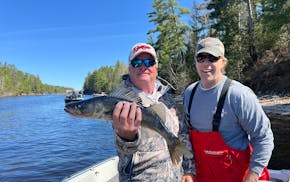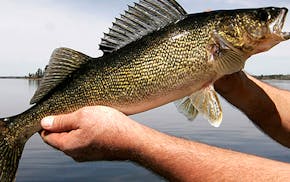With his wife, Jade Thomason, Carl Haensel operates Namebini, a fly-fishing guide service headquartered in Duluth that specializes in rivers along the north and south shores of Lake Superior. Together the couple recently published a comprehensive book, "Fly Fishing Minnesota," which offers detailed information about how and where to fly fish in the state not only for trout, but for bass, northern pike and other species.
In advance of the statewide stream trout season that opens Saturday, April 15, Haensel offers 10 steps prospective fly anglers can follow while wading into a sport many devotees find life-changing.
Seek information and advice. "Fly Fishing Minnesota" is a good place to start. Together with its companion spiral-bound lay-flat publication, "Minnesota Fly Fishing Maps," The book is a wealth of information about gear, flies and rivers and other waters to fish.
"Jade and I wanted to create a book for people throughout the state who want to get into fly fishing and also who are experienced anglers who perhaps are looking for new places to fish and different fish to catch," Haensel said. "I was fortunate in that I started fly fishing with my Dad. But for those who didn't have a family member to learn from, seeking information is important. Local fly shops can be a wealth of information, too, as can local chapters of conservation groups such as Trout Unlimited."
Purchase or borrow equipment. Disregard the well-established trend among outdoor equipment manufacturers that suggests that "only the best and most expensive gear will do." You can be assured that when Izaak Walton published "The Compleat Angler" in 1653 he owned neither a Gore-Tex raincoat nor a $1,000 fly rod with titanium guides. Introductory fly fishing outfits can be bought for a couple hundred bucks, and used rods and reels are available online at various sites. You will want advice about the size of rig to buy, however, as well as lines and leaders. So talk with friends and/or local fly shops before you pony up hard cash.
Practice casting. To catch a trout or any other fish on a fly, you needn't be Paul Maclean, the character portrayed by Brad Pitt in "A River Runs Through it." In that movie, Maclean is shown "shadow casting" long loops of fly line on what was portrayed to be the Big Blackfoot River in Montana (actually, angler Jason Borger, not Pitt, did the casting, and the scene was shot on the Gallatin River, not the Blackfoot).
"Fly-casting lessons are widely available, from local parks and recreation centers, to fly shops, to pros who teach casting," Haensel said. "Backyards or parks or lakes with still water are good places to get experience with fly rods."
Pick a fishy time of year to start. "You want everything working for you when you begin, so I always advise people new to fly fishing to start in April and May, for example, if they're fishing for trout in southeast Minnesota," Haensel said. "Spring is also a good time to fly fish for sunnies and crappies. You want to start out when fish are accessible and flies are a good tool to catch them."
Which fly to try? Entomology is a multi-syllable word meaning "a branch of zoology concerning the study of insects." Fair enough. But one needn't be an entomologist to "match the hatch," for example, on southeast Minnesota's Whitewater River when the state's inland stream trout season begins. One shortcut? Check out Haensel and Thomason's book (or, oftentimes, handouts from fly shops). The book includes a comprehensive hatch chart showing which bugs appear when in, on and above Minnesota streams.
Observe first, then fish. "Having gotten your gear together at the car, it's very easy to walk up to a stream and start casting," Haensel said. "Far better is to observe the stream first. Most trout streams are formed in 'riffle, run, pool' scenarios. You can be pretty sure that trout are in deep pools, but the active fish will often be in the moving water leading to or from the pool. Look closely also for any insects you might see hatching, perhaps 'caddis flies' skittering across the stream surface or 'mayflies' lying flat and still. Most important when you do cast is to have your fly drift downstream at the same speed as the current. If you can present your fly in this natural way, you'll catch trout."
Try for bass or other "warm water" species. "A great thing about Minnesota," Haensel said, "is that it offers so many different species of fish that can be caught on flies." The aforementioned panfish — meaning, generally, sunfish and crappies — are certainly among these, as are bass, largemouth as well as smallmouth. From Lake of the Woods and Rainy Lake on the state's northern border, to the Mississippi River as it leaves the state in the southeast, Minnesota offers some of the best fly fishing in the nation for smallmouth bass. "A lot of anglers who start out fly fishing for trout switch eventually to warm-water species because there are so many opportunities in Minnesota," Haensel said.
Yes, you can tie a fly. Sometimes anglers who "get the bug" for fly fishing expand their interests and begin tying their own flies. Other fly anglers reasonably believe fly shops exist for a reason, namely to sell them flies. Either way catches fish.
Conservation and fly fishing. "Fly anglers seem to become advocates of river and stream conservation pretty quickly," Haensel said. "One reason is that trout are fragile. They depend on cold water, and when cold water is lost or habitat is impaired, trout are lost." At one time, for example, the Twin Cities had many cold-water streams that supported trout populations. Now, most of the state's cold-water streams lie in southeast and northeast Minnesota, and anglers who fish these waters are among the most ardent protectors of these waters, especially anglers who belong to Trout Unlimited, the Lake Superior Steelhead Association and similar groups.
Enjoy the ride. No matter a fly angler's casting skills, fishing acumen or cold-water stewardship interests, he or she quickly learns that the sport — perhaps it's better called a pastime, or lifestyle — of seeking trout, bass or other fish with a fly rod is not only a never-ending learning experience, but a great way to meet people with similar interests. As a bonus — as the late fly fisherman and Esquire magazine co-founder and editor Arnold Gingrich once said — the fly angler soon enough realizes that "the fish is not so much your quarry, as your partner."
Anderson: The Chainsaw Sisters Saloon is gone, but the Echo Trail is still a pathway to possibilities

Anderson: Crane Lake gives up its walleyes — and its memories
Anderson: Minnesota's million anglers should be convinced that Boundary Waters is worth protecting

You asked, and we answered our audience's questions about Minnesota's fishing opener.


